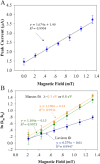Magnetoreception of Photoactivated Cryptochrome 1 in Electrochemistry and Electron Transfer
- PMID: 31458694
- PMCID: PMC6641772
- DOI: 10.1021/acsomega.8b00645
Magnetoreception of Photoactivated Cryptochrome 1 in Electrochemistry and Electron Transfer
Abstract
Cryptochromes are flavoproteins whose photochemistry is important for crucial functions associated with phototropism and circadian clocks. In this report, we, for the first time, observed a magnetic response of the cryptochrome 1 (CRY1) immobilized at a gold electrode with illumination of blue light. These results present the magnetic field-enhanced photoinduced electron transfer of CRY1 to the electrode by voltammetry, exhibiting magnetic responsive rate constant and electrical current changes. A mechanism of the electron transfer, which involves photoinduced radicals in the CRY, is sensitive to the weak magnetic field; and the long-lived free radical FAD•- is responsible for the detected electrochemical Faradaic current. As a photoreceptor, the finding of a 5.7% rate constant change in electron transfer corresponding to a 50 μT magnetic field may be meaningful in regulation of magnetic field signaling and circadian clock function under an electromagnetic field.
Conflict of interest statement
The authors declare no competing financial interest.
Figures





References
-
- Gressel J. Blue light photoreception. Photochem. Photobiol. 1979, 30, 749–754. 10.1111/j.1751-1097.1979.tb07209.x. - DOI
LinkOut - more resources
Full Text Sources
Research Materials

